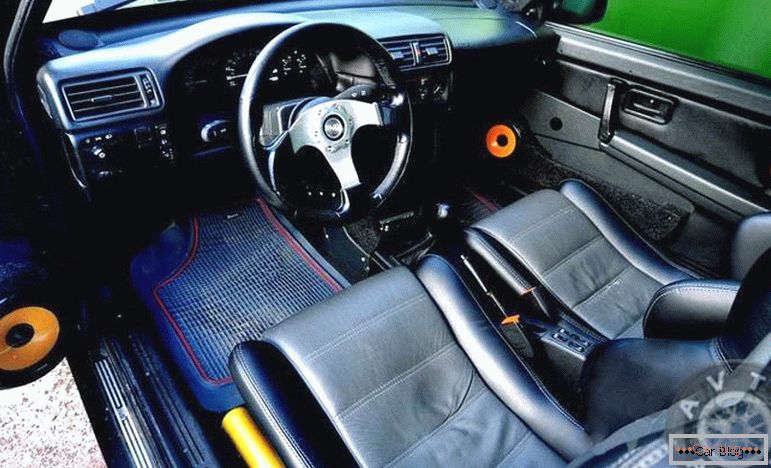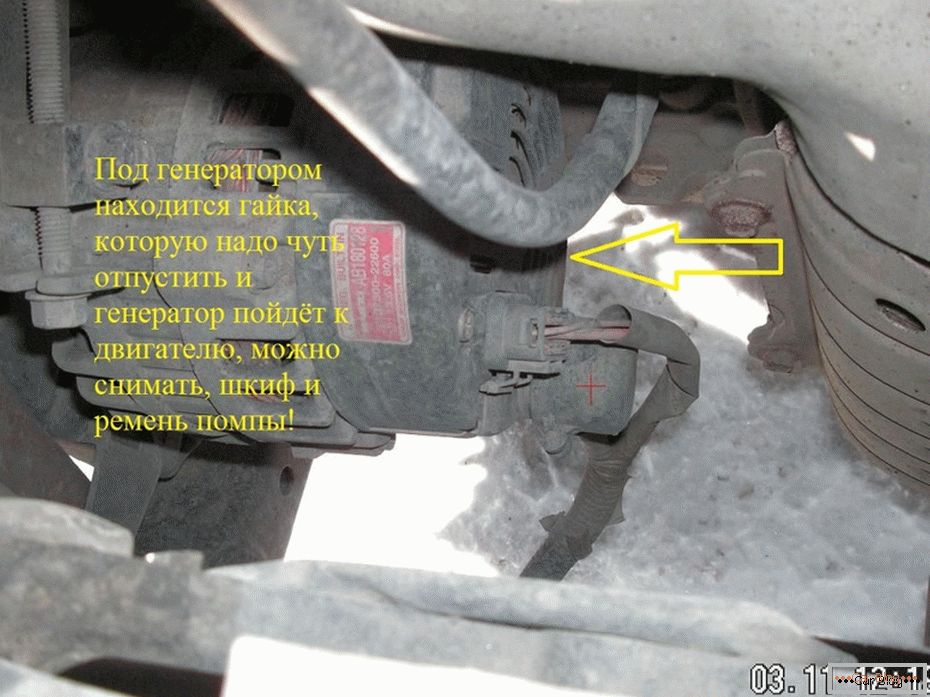In the cooling system of the car, the most vulnerable element is the radiator. It is located in the front of the engine compartment, and is the first to encounter external mechanical pollution. Sometimes such meetings are fraught with significant damage, after which an immediate repair of the car's radiator is required.
Since the design of the entire system does not imply quick disassembly, you need to take care of the safe operation of all elements involved in the process of cooling the motor. Otherwise, the failure of cooling can lead to sad consequences for the power plant. For example, there will be a jamming of pistons, and as a result expensive repair or full replacement of the block of cylinders with other nodes will be required. After all, it is impossible to go with non-working cooling.
Content
- 1 Why the cooling system stops working
- 2 Independent repair of elements of the cooling system
- 3 Dismantling the radiator
- 4 Cavities washing
- 5 Self-brazing
- 6 Cold brazing radiator
- 7 Internal micro-hole processing
- 8 Conclusion
Why the cooling system stops working
Failure of the radiator can occur not only because of mechanical or chemical damage, but also due to production or wear. Sometimes breakdowns occur when the unfair attitude of car owners to their car.
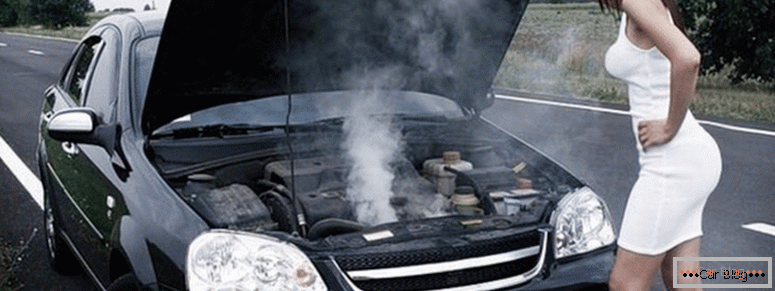
Boiling coolant
The most common causes of poor cooling performance are:
- scum and mud channels for the passage of coolant;
- poor circulation or its complete absence due to breakage of the pump;
- coolant leak through cracks or other unauthorized holes in the system.
Besides the fact that a coolant leak requires regular topping up of antifreeze, and this is a constant financial expense, there are operational problems:
- small volume of fluid circulating in the system leads to an undesirable increase in the operating temperature of the power plant;
- hot liquid may cause burns in contact with skin;
- antifreeze fumes are toxic and cause poisoning by inhalation for a long time.
The blockage of the passage channels in one circulation zone leads to overheating in other parts.
Due to this place, soldering can quickly oxidize until cracks appear at such joints, which also leads to additional leaks. In this case, a new brazing of the engine cooling radiator on cracks that may form may help.
Independent repair of elements of the cooling system
Almost all car service stations offer to perform leak repair work. However, for such an operation you will need to pay from 1000 to 7000 rubles, depending on such factors:
- the complexity of disassembly and class cars (passenger, cargo);
- radiator material (copper, aluminum, plastic);
- the extent of damage (in one or several places, the size of the hole, the need to replace the elements);
- additional operations (washing, external cleaning, etc.);
- required work speed.
In this case, it will be more profitable to repair the cooling radiator with your own hands, especially if the flow is small and visible. To do this, you need to stock up on time and materials for soldering or welding.
Dismantling the radiator
Soldering or welding of the radiator is carried out after removing it from the car. Dismantling need start after the car has cooledand the antifreeze temperature will drop. After that, it is necessary to drain the coolant through the holes at the bottom of the radiator and at the bottom of the cylinder block.
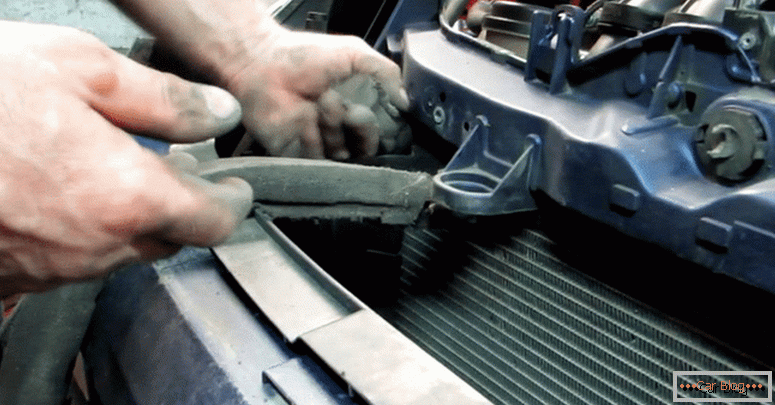
Dismantling the radiator
If the design does not provide for such drains, then it will be necessary to disconnect the pipes from the radiator. Before performing such an operation, you need to install the car on a flat horizontal surface, fold the battery terminals, substitute a container of sufficient volume for draining coolant to the drain points. After removing the fluid from the system, you can unscrew the sensors and wiring from the radiator and unscrew the fasteners for dismantling.
Washing cavities
Soldering a car radiator with your own hands should be carried out only on a clean, non-polluting device. To do this, the radiator is washed with running water from dirt, corrosive deposits and lime salts.
You can use chemical reagents for washing.
They are dissolved in water according to the instructions, and then, having closed the holes, they are poured inside. After waiting for the desired reaction after a specified time, the water with mud must be drained. Then again wash with running water from the remnants of "chemistry".
To get rid of oily contaminants, you can use a weak solution of solvent or solvent. After they also require washing with water.
Self-brazing
To do this, you will need solder, flux, ensuring the absence of oxygen in the soldering zone, a powerful soldering iron from 100 watts. The detected leak should be cleaned from oxides and dirt. Next, this place should be applied flux, soldering acid or rosin.
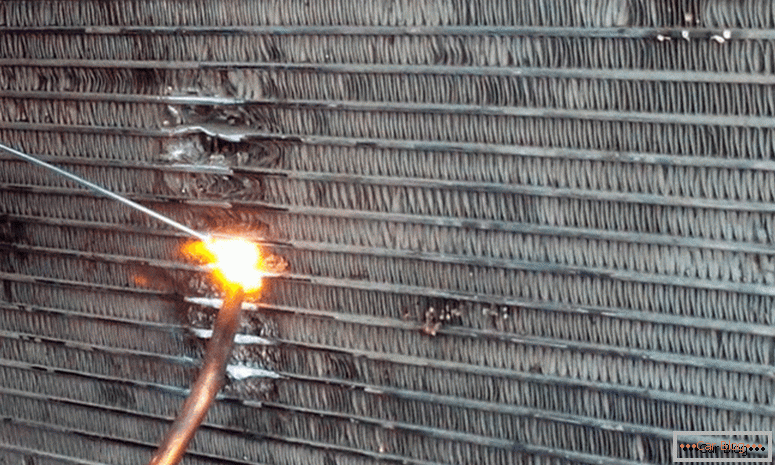
Soldering a radiator with your own hands
Beforehand, you need to heat the processing point with a soldering iron. For such an operation also suitable gas mini-burner. Then you need to apply the solder in sufficient quantities, and distribute it in the soldering zone. After waiting for complete cooling, you can check the quality of soldering with a compressor. It is connected to one of the radiator holes lowered into the water. The absence of air bubbles indicates high-quality soldering. After installing the radiator in its place, you need to fill the system with new antifreeze.
Next, you need to let the engine idle for about half an hour to check if there are no leaks in the system after self-repair.
Cold brazing
On the way from such troubles as leaking in a radiator, the “cold welding” method will save. To do this, use epoxy glue of two components. Working with him is quite simple. To do this, mix its parts and apply with a spatula to the hole with a leak. Having muffled an unwanted gap, you can get to the nearest station for a complete repair.
See also: How to change the radiator stove in the VAZ 2114Internal micro hole processing
If there is a noticeable leak on the level of liquid in the system, but there are no visible places with drips, then the problem is solved with the help of additives. Automobile "chemistry" allows you to patching small cracks with the help of "internal processing".
In this way, you can get rid of small leaks in places difficult for ordinary soldering. It is important to choose the right tool that does not create new problems with blockage in narrow channels. There are precedents when, due to such funds, the radiator channels of the stove were blocked, as the radiator itself is small and the inner tubes are narrow.
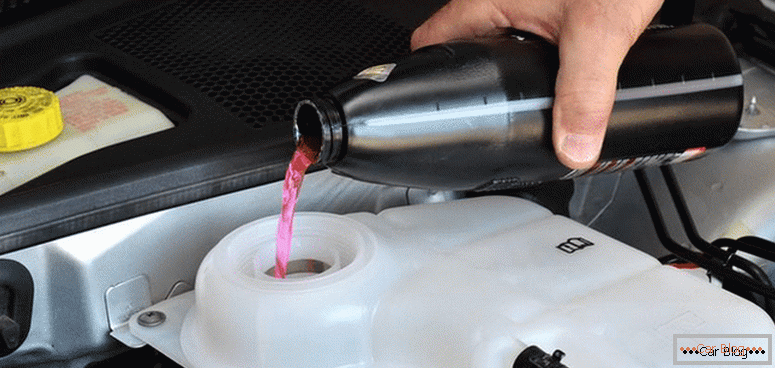
Add tomponing substances
It is necessary to add reagents through the throat of the radiator to the cooling system, then start the engine and warm it up for a quarter of an hour at idle. During this time, tamponage of microcracks and cracks is carried out.
The advantages of this method include the ease of use and the lack of disassembly of the system. However, you need to strictly follow the instructions for dosage and modes of use.
Liquid drugs, unlike powdered substances, are more expensive, but more effective and reduce the possibility of thrombosis of the channels.
Conclusion
You can solder the radiator yourself in the presence of a powerful soldering iron, solder and flux. For small cracks, it is possible to use automotive special tools poured into antifreeze without disassembling a radiator. On the way, they will help out a two-component kit for "cold soldering" of radiators.

